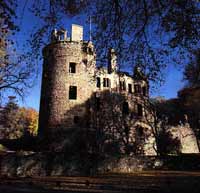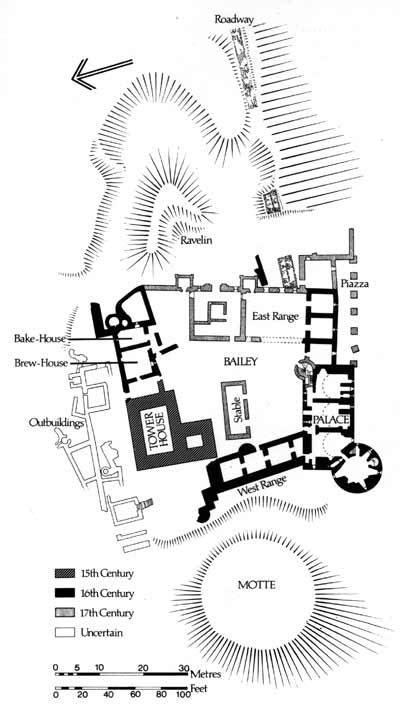 The
2nd Marquis stood for the king in the Civil War, and sealed
his devotion on the scaffold. ‘You may take my head
from my shoulders’, he told the Covenanters, ‘but
not my heart from my sovereign’. His castle suffered
sorely for the loyalty of its lord. The
2nd Marquis stood for the king in the Civil War, and sealed
his devotion on the scaffold. ‘You may take my head
from my shoulders’, he told the Covenanters, ‘but
not my heart from my sovereign’. His castle suffered
sorely for the loyalty of its lord.
 In
1640 it was occupied by the army of the Covenant under Major-General
Monro. The parson of Rothiemay tells us how the house ‘was
preserved from being rifled or defaced, except some emblems
and imagerye, which looked somewhat popish and superstitious
lycke; and therefore, by the industry of one captain James
Wallace (one of Munroe’s foote captaines) were hewd
and brocke doune off the frontispiece of the house; but all
the rest of the frontispiece containing Huntly’s scutcheon,
etc, was left untouched, as it stands to this daye’. In
1640 it was occupied by the army of the Covenant under Major-General
Monro. The parson of Rothiemay tells us how the house ‘was
preserved from being rifled or defaced, except some emblems
and imagerye, which looked somewhat popish and superstitious
lycke; and therefore, by the industry of one captain James
Wallace (one of Munroe’s foote captaines) were hewd
and brocke doune off the frontispiece of the house; but all
the rest of the frontispiece containing Huntly’s scutcheon,
etc, was left untouched, as it stands to this daye’.
In October, 1644, the castle was briefly held by Montrose
against Argyll. In 1647 it was gallantly defended against
General Leslie by Lord Charles Gordon, but its 'Irish' garrison
was starved into surrender. Savage treatment was meted out,
for the men were hanged and their officers beheaded. In
December of the same year Huntly himself was captured and
on his way to execution at Edinburgh was detained, by a
refinement of cruelty, in his own mansion. His escort were
shot against its walls. In 1650 Charles II visited briefly
on his way to Worcester, defeat and exile.
The Civil War ended the Huntly family's long occupation
of the castle. In the early eighteenth century it was already
in decay and providing material for predatory house builders
in the village. In 1746, during the Jacobite rising, it
was occupied by Government troops. Thereafter, it became
a common quarry until a groundswell of antiquarian sentiment
in the 19th Century came to the rescue of the noble pile.

|




